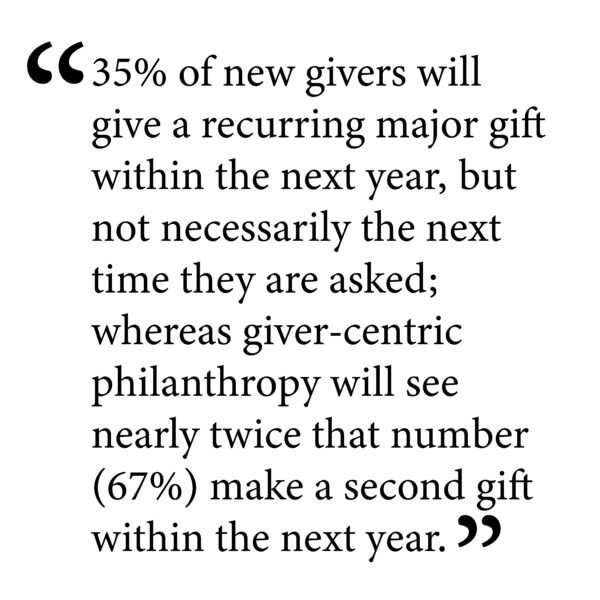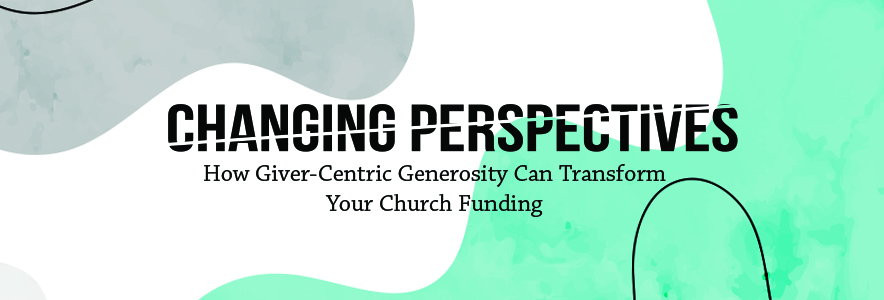The two main fundraising strategies throughout American Church history are the annual stewardship and capital fundraising campaigns. These strategies have yielded dollars to churches from givers committed to fulfilling their church’s mission and goals. These approaches are similar because project-based initiatives and time constraints characterize both. For example, a fundraising appeal is usually structured something like this, “Would you consider making a generous gift so that we as a church can (fill in the blank) by (time-sensitive parameter)?” Notice that in traditional fundraising, the project(s) and the timeline serve as the central focus. The interests and values of the giver often become secondary, except that a tax deduction will be forthcoming on their annual giving statement.
Compare and contrast that approach with giver-centric philanthropy, also known as donor-centric philanthropy. Giver-centric philanthropy is designed to place each giver and their interests at the center of the church’s stewardship and generosity endeavors. It involves an in-depth consideration of individual givers’ interests, motivations, affinities, and propensities to contribute to a cause. It places the giver as the centralizing focus and recognizes that the gifts will follow if you have the giver’s passions and interests in mind.
This strategy will inspire givers toward increased tenure and to express their generosity from non-cash assets, which account for approximately 97% of their wealth holdings. The approach also fulfills three essential requirements from givers.
- To receive prompt and meaningful acknowledgement for their gift from a senior leader;
- To be able to speak into and direct the intent of each gift they make, regardless of the size, which may involve a narrower scope than the organizational mission as a whole; and,
- To be able to receive measurable feedback on what was accomplished with their last gift before being asked for another.
According to Cygnus Applied Research, traditional fundraising lags giver-centric philanthropy in the following key performance indicators:
- In traditional fundraising, 35% of new givers will give a recurring major gift within the next year, but not necessarily the next time they are asked; whereas giver- centric philanthropy will see nearly twice that number (67%) make a second gift within the next year.
- Only 21% of those with the fundraising model will give a larger second gift, versus 52% of those who are invited to give a second gift when it’s giver-centric.
- Traditional fundraising will experience more “donor fatigue.” Less than 10% will respond to more than five “asks” or campaigns. Compare that to 67% of donor-centric givers who will respond favorably for an indefinite period of time.

What are the key shifts needed to make to transition from church centric to giver-centric philanthropy?
The common phrase, “We want something for you, and not from you,” alerts us to the ultimate goal of growing our people in every area of their lives, including stewardship and generosity. Our calling as church leaders is, first and foremost, to be faith raisers, not fundraisers. Therefore, clarity around your stewardship theology is foundational to the process.
The case for support identifies and outlines the evergreen causes that your church will indefinitely support. It is crucial to have 3-4 big picture items your church is trying to solve in your community and the world. Each of these “lanes of support” may have projects beneath them as action steps toward the main objective. For example, the homeless crisis in our city is a lane, whereas building a homeless shelter is a project.
Giver-centric philanthropy takes time. While giving is the voluntary transfer of property from the giver to a recipient, generosity involves a “stop and think about it” gift. Givers need to be cultivated over time to make major gifts, especially when considering a gift from non-cash assets. Major gifts are seldom, if ever, given impulsively or when pressured.
Many fundraising appeals are done en masse through marketing mailouts, newsletters, emails, and platform announcements. Giver-centric philanthropy believes that “the whites of their eyes matter” and that vision is most transferable through people, not paper. The personal approach will allow givers to use their gifts to solve the problems that arise from life events or tax liability. It will also enable the giver to speak into their gift and provide input based upon the things that break their hearts.
For those living in the fourth quarter of life, consideration of having a lasting legacy becomes heightened. Many have learned how to become successful but are now concerned about whether or not their lives have been significant. Giver-centric philanthropy provides the guidance givers are looking for as they seek to complete their life story. A thousand years from now, what will really matter?
With these things in mind, giver-centric philanthropy believes it is essential to personalize donor experiences and build giver loyalty over time. This process may involve including givers in the decision-making process, respecting the particular issues they are passionate about, developing deepened relationships, and having multiple touch points with them at different stages of their journey.
Giver-centered philanthropy has stood the test of time in the not-for-profit sector and has been known to raise larger and more consistent gifts. If your church is interested in using this strategy to fund your current ministry and fuel future sustainability, we’d love to hear from you and share how MortarStone can help you with the process.
